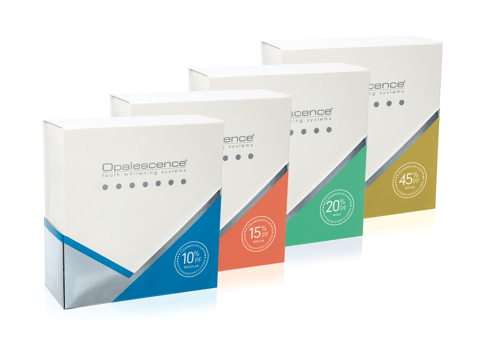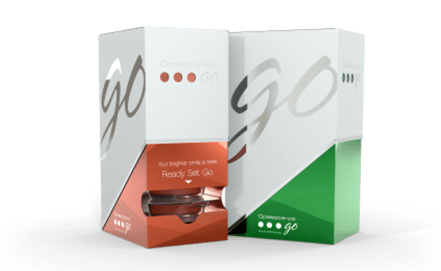Everyone’s smile is powerful. A smile can break down barriers, cut through tension, make a stranger feel welcome, and lift a friend’s day. The problem is that many people are too self-conscious to show their unique smile to the world, and Opalescence whitening is on a mission to change that. Whether someone has coffee- or wine-stained teeth, teeth that are a little crooked, or a smile flanked by dimples large or small, everyone has a reason to celebrate their uniqueness. Something that often helps those who are self-conscious about their smile is tooth whitening. However, concerns and questions abound about this hot topic: Will whitening damage my teeth? Exactly how white can I get my teeth? How long will the whitening last? Is the chemical used in tooth whitening toxic?
We’re here to help, and in doing so, help your patients embrace their most confident, powerful smile. Let’s get right to it.

Opalescence® PF tooth whitening system
(percentages may vary by country)
Will whitening damage my teeth?
There’s been a long-standing fear with patients that tooth whitening could damage their enamel through decalcification. The reality is that decalcification is caused by exposure to acidity, a low pH in the mouth. For this reason, all Opalescence® tooth whitening products feature a nearly neutral pH that closely matches the pH of a patient’s mouth.

Lifestyle, age, and other factors determine how quickly teeth whiten, and how long it lasts.
Exactly how white can I get my teeth, and how long will it last?
This can be a somewhat tricky question, as many factors come into play to determine just how white a patient can get their teeth, and how long those results will last. Here’s what Dr. Fischer, founder and CEO of Ultradent says: “Everyone is different and it’s important that we never promise a patient that they’ll arrive at a certain shade. What we do tell them is that we’ll most likely achieve a significant level of whitening, and we have found that they’re usually thrilled with the results.”
The amount of coffee or wine one drinks, the frequency of consumption of staining foods like tomato sauces, certainly smoking, hygiene, and even genetics come into play when it comes to the ultimate shade of white each individual patient can achieve. Those factors can also influence the longevity of the results, and how often the patient will need to touch up. However, like Dr. Fischer says, most patients experience significant whitening from their original shade and leave the dental office thrilled with their results!

Opalescence® Boost® in-office whitening
(percentages may vary by country)
Is the chemical used in tooth whitening toxic?
Opalescence whitening products are made of materials commonly found in or readily disposed of by the body, such as hydrogen peroxide and carbamide peroxide. Carbamide peroxide is a combination of hydrogen peroxide and urea, which stabilizes the peroxide to allow for a slower release and longer wear time. Under proper dentist supervision and adherence to the product’s instructions, Opalescence tooth whitening products are not toxic.

Opalescence Go® prefilled, disposable whitening system
(percentages may vary by country)
Can I whiten my teeth while I have braces?
Yes! It’s a common misconception that patients have to wait until after they’re finished with braces and other orthodontic treatments to whiten. The truth is, patients can whiten while their brackets are on because the peroxide in whitening gel penetrates beneath the brackets and spreads throughout the tooth to whiten and brighten the entire tooth.6Opalescence Go® prefilled, disposable whitening trays are designed to mold to the tooth, so they fit directly over braces easily and comfortably. They are a great, affordable option for both orthodontic and non-orthodontic patients.
1. Basting RT, Rodrigues AL Jr, Serra MC. The effects of seven carbamide peroxide bleaching agents on enamel microhardness over time. J Am Dent Assoc. 2003;134(10):1335-42.
2. Al-Qunaian TA. The effect of whitening agents on caries susceptibility of human enamel. Oper Dent. 2005;30(2):265-70.
3. Clark LM, Barghi N, Summitt JB, Amaechi BT. Influence of fluoridated carbamide peroxide bleaching gel on enamel demineralization. J Dent Res 85(Spec Iss A): 0497, 2006 (www.dentalresarch.org).
4. Amaechi BT, Clark LM, Barghi N, Summitt JB. Enamel fluoride uptake from fluoridated carbamide peroxide bleaching gel. J Dent Res 85(Spec Iss A): 0498, 2006 (www.dentalresarch.org).
5. Browning WD, Myers M, Downey M, Pohjola RM, Brackett WW. Report on low sensitivity whiteners. J Dent Res 85(Spec Iss A): 1650, 2006 (www.dentalresarch.org).
6. Jadad E, Montoya J, Arana G, Gordillo LAA, Palo RM, and Loguercio AD. Spectrophotometric evaluation of color alterations with a new dental bleaching product in patients wearing orthodontic appliances. Am J Orthod Dentofacial Ortho. 2011;140(1):e43-47.







